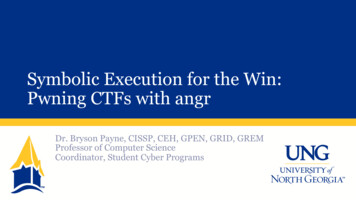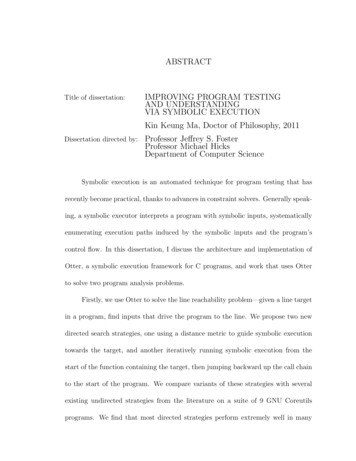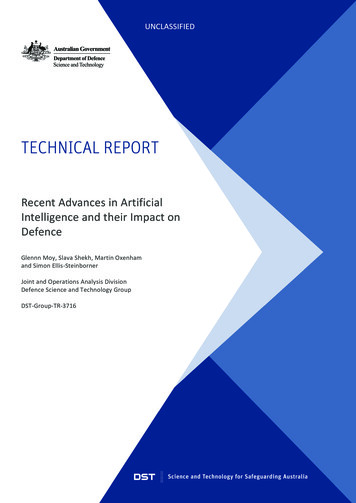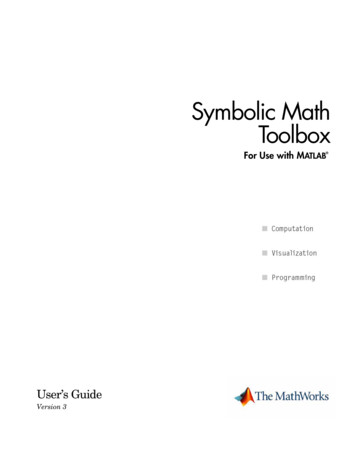
Transcription
Symbolic Execution for the Win:Pwning CTFs with angrDr. Bryson Payne, CISSP, CEH, GPEN, GRID, GREMProfessor of Computer ScienceCoordinator, Student Cyber Programs
About Me Dr. Payne: Ph.D. in computerscience from Georgia StateUniversity, 6 years as a CIO,24 years teaching CS/IS/Cyber inthe University System Author of Teach Your Kids to Code,Go Hack Yourself; next bookHacking for Kids comes out Jan2023 Coach for the #1 2019 & 2020 NSACodebreaker Challenge Coaching Staff for US Cyber Team
Intro Competitions and CTFs motivate and engagestudents in cybersecurity and cyber ops Reverse engineering and pwn/binary exploitchallenges are common in CTFs, but the tools havea steep learning curve, not all programs teach RE angr is a Python framework for analyzing binaries Built as part of DARPA Cyber Grand Challenge Can be used to solve CTF challenges (and find realvulnerabilities) in almost automated fashion
What is angr? angr is a multi-architecture binary analysis toolkit Can perform both static and dynamic, concrete andsymbolic (or concolic) analysis, including: Disassembly Symbolic execution Control-flow analysis Data-dependency analysis Value-set analysis (VSA) Decompilation
Steps in Symbolic Execution w/angr Load a binary for analysis Translate the binary into intermediate representation Perform symbolic exploration of the program’s possible states Explore to find the states that lead to a win/success state in a CTF [Optional: avoid states that lead to loss/failure]
Installing angr in Python Kali:#angrsudo apt install python3-pippip install angrpip install pycparser --force Windowspip3 install angr Virtualenv recommended Official docs/install ata/install
All sample files from today Challenge binaries are courtesy of Point3’s ESCALATE platform https://tinyurl.com/CAETechTalk-angr
Simple angr CTF attack:import angr, claripyproject angr.Project('Lin64 1')flag claripy.BVS('flag',8*256) # variable we’re solving forstate project.factory.entry state(args ['Lin64 1', flag])simgr project.factory.simulation manager(state)simgr.explore(find 0x004005c6) # “success” addressprint(simgr.found[0].solver.eval(flag, cast to bytes))
Demo – Ghidra and angr Do quick analysis in Ghidra to find “win/success” Plug in this address to the simulation manager’s explore method asthe “find” address
Refining our angr We can clean up the flag to a shorter bit vector We can add a list of addresses to avoid in the explore method
Faster angrimport angr, claripyproject angr.Project('Lin64 2')flag claripy.BVS('flag',8*39)state project.factory.entry state(args ['Lin64 2', flag])simgr project.factory.simulation manager(state)simgr.explore(find 0x00400896, avoid ast to bytes))
Clean up error messages with options Add to the entry state:add options {angr.options.SYMBOL FILL UNCONSTRAINED MEMORY,angr.options.SYMBOL FILL UNCONSTRAINED REGISTERS}
import angr, claripyproject angr.Project('Lin64 3’)flag claripy.BVS('flag',8*39)state project.factory.entry state(args ['Lin64 3',flag],add options {angr.options.SYMBOL FILL UNCONSTRAINED MEMORY,angr.options.SYMBOL FILL UNCONSTRAINED REGISTERS})simgr project.factory.simulation manager(state)simgr.explore(find 0x004006f9, avoid [0x40070f])print(simgr.found[0].solver.eval(flag, cast to bytes).decode('utf-8')
Additional optimizations Flag values (and input strings) are usually printable characters,ASCII 0x20-0x7e (space to ) – most CTFs exclude the space We can add constraints to each byte of the flag symbol:for byte in flag.chop(8):state.solver.add(byte 0x7f)state.solver.add(byte 0x20)
Demos Clever multi-solver with lambda function based on output Windows solvers
What if the flag is stdin input?input length 39input chars [claripy.BVS("char %d" % i, 8) for i in range(input length)]input claripy.Concat(*input chars)state proj.factory.entry state(args ["./file"], stdin input)for byte in input chars:state.solver.add(byte 0x20, byte 0x7e) print(simgr.found[0].solver.eval(input, cast to bytes).decode('utf-8'))
Conclusion angr is a symbolic execution tool worth introducing to yourReverse Engineering students and CTF competition teams angr can be used by novices and experts alike, often in a fraction ofthe time required with debuggers, disassemblers, and decompilers But, you probably still need some basic RE skills (Ghidra) All files from today: https://tinyurl.com/CAETechTalk-angr Q&A – Thank You!
a steep learning curve, not all programs teach RE . angris a multi-architecture binary analysis toolkit Can perform both static and dynamic, concrete and symbolic (or concolic) analysis, including: Disassembly Symbolic execution Control-flow analysis . BVS('flag',8*39) state project.factory.entry_state(args ['Lin64_3',flag .










